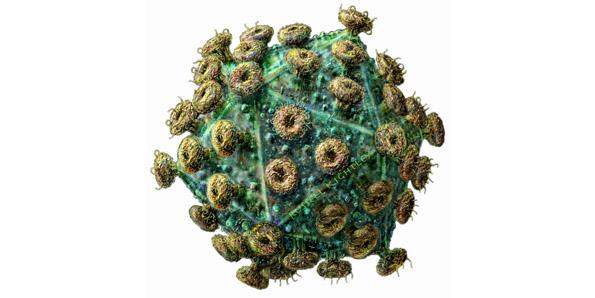

| Visitors Now: | |
| Total Visits: | |
| Total Stories: |
Top 10 Lethal Viruses Present Today

Viruses can be defined as a microscopic infectious pathogenic agent that can only replicate within the living cells on an organism. In other words, even though they are rather small and can be observed exclusively through the lens of a microscope, their nature as well as the fact that they infect virtually any type of organism from humans and animals to plants and bacteria is what makes them the world’s most prolific killers.
In spite of the efforts medicine has made to eradicate them through the ages, the viruses are very resilient and new ones appear every day. In fact, nowadays over 5,000 known viruses claim the lives of thousands of people worldwide. Let’s find out the more about the invisible assassins out there that are on the lookout for their next victim.
1. HIV
 HIV or the Human Immunodeficiency Virus represents the deadliest virus of the planet. HIV kills over 3 million people each year needs no further presentation, it has no effective cure except prevention, it can stay latent for more than 15 years and it leaves the infected person defenseless in the face of numerous infections.
HIV or the Human Immunodeficiency Virus represents the deadliest virus of the planet. HIV kills over 3 million people each year needs no further presentation, it has no effective cure except prevention, it can stay latent for more than 15 years and it leaves the infected person defenseless in the face of numerous infections.
2. H1N1 virus
 When Alexander Flaming discovered penicillin, it was believed that medicine had finally found a cure for the common cold and its older eccentric brother, influenza. Nothing can be further from the truth and the recent epidemics of swine and aviary flu stand as proof of that. The H1N1 virus is an airborne agent that quickly makes its way into the lungs and takes hold of the mechanisms of the cells. While many infected people recover within a maximum of two weeks, it is necessary to mention that the infection is highly contagious and that people with preexisting respiratory conditions face a high risk of death.
When Alexander Flaming discovered penicillin, it was believed that medicine had finally found a cure for the common cold and its older eccentric brother, influenza. Nothing can be further from the truth and the recent epidemics of swine and aviary flu stand as proof of that. The H1N1 virus is an airborne agent that quickly makes its way into the lungs and takes hold of the mechanisms of the cells. While many infected people recover within a maximum of two weeks, it is necessary to mention that the infection is highly contagious and that people with preexisting respiratory conditions face a high risk of death.
3. HCV
 At this point, it is estimated that around 300 million people are infected with HCV or Hepatitis C and they do not even know it. In fact, most of the individuals only learn about the condition years later when they first experience signs of liver failure. The good news is that the infection only spreads via direct contact with the blood, mainly from tattoos, piercing, sharing a syringe needle, blood transfusion and organ transplants. While the chances of contagion are limited, the WHO reports that Hepatitis C is the main reason for liver transplants. Deaths due to liver failure and complications are estimated at half a million globally per year.
At this point, it is estimated that around 300 million people are infected with HCV or Hepatitis C and they do not even know it. In fact, most of the individuals only learn about the condition years later when they first experience signs of liver failure. The good news is that the infection only spreads via direct contact with the blood, mainly from tattoos, piercing, sharing a syringe needle, blood transfusion and organ transplants. While the chances of contagion are limited, the WHO reports that Hepatitis C is the main reason for liver transplants. Deaths due to liver failure and complications are estimated at half a million globally per year.
4. Rotavirus
 According to the World Health Organization, every child on this planet will get infected with the Rotavirus at least once until the age of five. While in the developed countries the Rotavirus is very unlikely to claim any victims, in under-developed states it takes the lives of more than half of a million children. Take note that while the virus affects the digestive tract and its main symptom consists of diarrhea, it is not mandatory that a child exhibits this sign during a Rotavirus infection.
According to the World Health Organization, every child on this planet will get infected with the Rotavirus at least once until the age of five. While in the developed countries the Rotavirus is very unlikely to claim any victims, in under-developed states it takes the lives of more than half of a million children. Take note that while the virus affects the digestive tract and its main symptom consists of diarrhea, it is not mandatory that a child exhibits this sign during a Rotavirus infection.
5. HBV
 Similar to Hepatitis C, the virus responsible for Hepatitis B can be transmitted via exposure to infected blood. Even though the virus attacks the liver, the WHO claims that over 90% of the adults and older children contaminated with Hepatitis B will make a full recover, despite the fact that there is no specific treatment for the infection. However, compared to HCV, the symptoms of Hepatitis B are more unpleasant, as its trademark consists of a persistent yellowing of the skin.
Similar to Hepatitis C, the virus responsible for Hepatitis B can be transmitted via exposure to infected blood. Even though the virus attacks the liver, the WHO claims that over 90% of the adults and older children contaminated with Hepatitis B will make a full recover, despite the fact that there is no specific treatment for the infection. However, compared to HCV, the symptoms of Hepatitis B are more unpleasant, as its trademark consists of a persistent yellowing of the skin.
2013-01-07 22:22:30
Source: http://top-10-list.org/2013/01/08/top-10-lethal-viruses/
Source:



